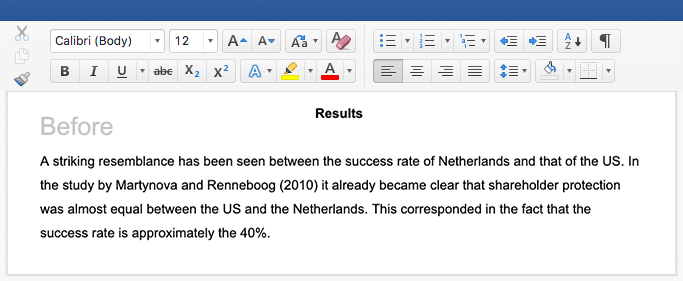
Published on 9 September 2022 by Tegan George and Shona McCombes. Revised on 10 October 2022.
The conclusion is the very last part of your thesis or dissertation. It should be concise and engaging, leaving your reader with a clear understanding of your main findings, as well as the answer to your research question.
In it, you should:
Be assured that you'll submit flawless writing. Upload your document to correct all your mistakes.

While your conclusion contains similar elements to your discussion section, they are not the same thing.
Your conclusion should be shorter and more general than your discussion. Instead of repeating literature from your literature review, discussing specific research results, or interpreting your data in detail, concentrate on making broad statements that sum up the most important insights of your research.
As a rule of thumb, your conclusion should not introduce new data, interpretations, or arguments.

When making recommendations for further research, be sure not to undermine your own work. Relatedly, while future studies might confirm, build on, or enrich your conclusions, they shouldn’t be required for your argument to feel complete. Your work should stand alone on its own merits.
Just as you should avoid too much self-criticism, you should also avoid exaggerating the applicability of your research. If you’re making recommendations for policy, business, or other practical implementations, it’s generally best to frame them as ‘shoulds’ rather than ‘musts’. All in all, the purpose of academic research is to inform, explain, and explore – not to demand.
Make sure your reader is left with a strong impression of what your research has contributed to the state of your field.
Some strategies to achieve this include:
Again, avoid simply repeating what you’ve already covered in the discussion in your conclusion. Instead, pick out the most important points and sum them up succinctly, situating your project in a broader context.
The end is near! Once you’ve finished writing your conclusion, it’s time to wrap up your thesis or dissertation with a few final steps:
Here is an example of how you can write your conclusion section. Notice how it includes everything mentioned above:
The current research aimed to identify acoustic speech characteristics which mark the beginning of an exacerbation in COPD patients.
The central questions for this research were as follows:
1. Which acoustic measures extracted from read speech differ between COPD speakers in stable condition and healthy speakers?
2. In what ways does the speech of COPD patients during an exacerbation differ from speech of COPD patients during stable periods?
All recordings were aligned using a script. Subsequently, they were manually annotated to indicate respiratory actions such as inhaling and exhaling. The recordings of 9 stable COPD patients reading aloud were then compared with the recordings of 5 healthy control subjects reading aloud. The results showed a significant effect of condition on the number of in- and exhalations per syllable, the number of non-linguistic in- and exhalations per syllable, and the ratio of voiced and silence intervals. The number of in- and exhalations per syllable and the number of non-linguistic in- and exhalations per syllable were higher for COPD patients than for healthy controls, which confirmed both hypotheses.
However, the higher ratio of voiced and silence intervals for COPD patients compared to healthy controls was not in line with the hypotheses. This unpredicted result might have been caused by the different reading materials or recording procedures for both groups, or by a difference in reading skills. Moreover, there was a trend regarding the effect of condition on the number of syllables per breath group. The number of syllables per breath group was higher for healthy controls than for COPD patients, which was in line with the hypothesis. There was no effect of condition on pitch, intensity, center of gravity, pitch variability, speaking rate, or articulation rate.
This research has shown that the speech of COPD patients in exacerbation differs from the speech of COPD patients in stable condition. This might have potential for the detection of exacerbations. However, sustained vowels rarely occur in spontaneous speech. Therefore, the last two outcome measures might have greater potential for the detection of beginning exacerbations, but further research on the different outcome measures and their potential for the detection of exacerbations is needed due to the limitations of the current study.
You've written a great conclusion! Use the other checklists to further improve your dissertation.
In a thesis or dissertation, the discussion is an in-depth exploration of the results, going into detail about the meaning of your findings and citing relevant sources to put them in context.
The conclusion is more shorter and more general: it concisely answers your main research question and makes recommendations based on your overall findings.
While it may be tempting to present new arguments or evidence in your thesis or disseration conclusion, especially if you have a particularly striking argument you’d like to finish your analysis with, you shouldn’t. Theses and dissertations follow a more formal structure than this.
All your findings and arguments should be presented in the body of the text (more specifically in the discussion section and results section.) The conclusion is meant to summarize and reflect on the evidence and arguments you have already presented, not introduce new ones.
For a stronger dissertation conclusion, avoid including:
Your conclusion should leave the reader with a strong, decisive impression of your work.
The conclusion of your thesis or dissertation shouldn’t take up more than 5-7% of your overall word count.
If you want to cite this source, you can copy and paste the citation or click the ‘Cite this Scribbr article’ button to automatically add the citation to our free Reference Generator.
George, T. & McCombes, S. (2022, October 10). How to Write a Dissertation Conclusion | Checklist and Examples. Scribbr. Retrieved 3 September 2024, from https://www.scribbr.co.uk/thesis-dissertation/conclusion/
Tegan is an American based in Amsterdam, with master's degrees in political science and education administration. While she is definitely a political scientist at heart, her experience working at universities led to a passion for making social science topics more approachable and exciting to students.
The introduction leads your reader into the dissertation. Describe the topic, focus, relevance, and objectives of your research.
910In the discussion, you interpret the meaning of the results and show why they matter. You can also note limitations and make recommendations.
1193An abstract is a short summary that appears at the start of your paper. It concisely reports your aims, methods, results and conclusions.